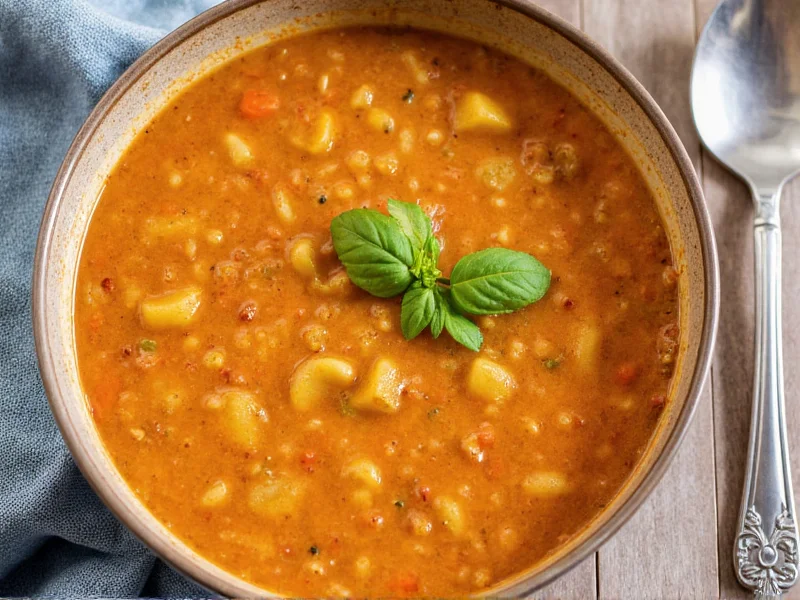When exploring the world of soup and fresh preparation, understanding the fundamental differences between homemade creations and store-bought alternatives is essential. Fresh soup maximizes nutritional benefits while delivering complex flavor profiles that processed versions simply cannot replicate. The magic happens when seasonal vegetables meet proper technique—transforming simple ingredients into nourishing meals that support both health and culinary enjoyment.
The Nutritional Advantage of Fresh Soup
Freshly prepared soups retain significantly higher levels of vitamins and minerals compared to canned counterparts. The thermal processing required for canning degrades heat-sensitive nutrients like vitamin C and certain B vitamins. A study published in the Journal of Food Science found that fresh vegetable soup maintained 30-40% higher nutrient levels than identical recipes processed for shelf stability.
| Nutrient | Fresh Soup (per cup) | Canned Soup (per cup) | Difference |
|---|---|---|---|
| Vitamin C | 28mg | 12mg | +133% |
| Vitamin A | 4500 IU | 3200 IU | +41% |
| Fiber | 4.2g | 2.8g | +50% |
| Sodium | 180mg | 890mg | -80% |
Essential Techniques for Fresh Soup Preparation
Mastering fresh soup preparation requires understanding ingredient timing and temperature control. The sequence in which you add components dramatically affects final texture and flavor. For vegetable-based soups, start with aromatics like onions and garlic, followed by harder vegetables (carrots, potatoes), then medium-density items (zucchini, green beans), finishing with delicate greens and fresh herbs in the last five minutes of cooking.
When preparing fresh vegetable soup recipes, blanching certain vegetables before adding to the broth preserves their vibrant color and crisp-tender texture. This technique works particularly well for green beans, asparagus, and broccoli. For creamy soups without dairy, consider blending cooked cauliflower or white beans to achieve luxurious texture while maintaining freshness.
Optimal Storage Methods for Maximum Freshness
Understanding how long does fresh soup last is crucial for food safety and quality preservation. Properly stored in airtight containers, most fresh soups maintain peak quality for 3-4 days in the refrigerator. The key to extending freshness lies in rapid cooling—divide large batches into smaller containers to facilitate quicker temperature reduction.
For those wondering how to keep soup fresh in refrigerator, follow these professional guidelines:
- Cool soup to room temperature within 2 hours of cooking
- Use shallow containers (no deeper than 2 inches)
- Leave 1-inch headspace for expansion if freezing
- Label containers with preparation date
- Store at or below 40°F (4°C)
Seasonal Ingredient Selection
The foundation of exceptional fresh soup lies in ingredient seasonality. Spring brings tender asparagus, peas, and baby greens perfect for light broths. Summer offers abundant tomatoes, zucchini, and fresh corn ideal for chilled soups. Autumn provides hearty squash, root vegetables, and mushrooms for robust preparations. Winter features hardy greens like kale and cabbage that withstand longer cooking times.
When selecting produce for fresh soup preparation techniques, look for firm vegetables with vibrant colors and crisp textures. Avoid items with soft spots, discoloration, or wilted appearance. For optimal flavor development, chop vegetables to uniform sizes to ensure even cooking.
Common Fresh Soup Mistakes to Avoid
Even experienced cooks make errors that compromise soup freshness. Overcooking vegetables destroys their texture and diminishes nutritional value. Adding salt too early can draw out moisture from vegetables, affecting flavor concentration. Using dried herbs instead of fresh ones significantly alters the final profile—remember that fresh herbs require three times the quantity of dried equivalents.
Many home cooks don't realize that best practices for storing homemade soup include leaving the lid slightly ajar during initial cooling to prevent condensation buildup, which dilutes flavor. Additionally, freezing soup with starchy ingredients like potatoes often results in undesirable texture changes upon thawing.
Reviving Leftover Fresh Soup
When reheating previously prepared soup, avoid boiling which can overcook remaining ingredients. Instead, warm gently over medium-low heat until steaming. For cream-based soups, whisk continuously to prevent separation. If the soup has thickened during storage, add small amounts of broth or water while reheating.
Enhance day-old soup by finishing with fresh herbs, a squeeze of citrus, or a drizzle of high-quality olive oil just before serving. These simple additions restore the vibrant qualities that define truly fresh soup.
Frequently Asked Questions
How long can fresh soup stay at room temperature?
Fresh soup should not remain at room temperature for more than two hours. Bacteria multiply rapidly between 40°F and 140°F (the 'danger zone'), making prompt refrigeration essential for food safety. During hot weather (above 90°F), reduce this timeframe to one hour.
Can you freeze fresh soup with dairy ingredients?
Soups containing dairy (milk, cream, cheese) often separate when frozen and thawed. For best results, either omit dairy before freezing and add it when reheating, or use dairy alternatives specifically formulated for freezing. Coconut milk and certain plant-based creams generally freeze better than traditional dairy.
What's the best container for storing fresh soup?
Glass containers with airtight lids provide the best protection against flavor transfer and maintain soup quality longest. If using plastic, choose BPA-free containers specifically designed for food storage. Avoid metal containers which can react with acidic ingredients like tomatoes. Always leave 1-2 inches of headspace for expansion during freezing.
How can you tell if fresh soup has spoiled?
Signs of spoiled fresh soup include sour or unpleasant odors, visible mold growth, bubbling or fizzing when not hot, and slimy texture. If the container lid is bulging or makes a popping sound when opened, discard immediately as this indicates bacterial growth. When in doubt, follow the food safety principle: 'When unsure, throw it out.'
Does freezing fresh soup affect its nutritional value?
Properly frozen fresh soup retains most nutrients for 2-3 months. The freezing process itself preserves nutrients, though some water-soluble vitamins may degrade over extended storage. Blanching vegetables before freezing soup helps maintain nutrient levels. For maximum nutritional benefit, consume frozen soup within three months and avoid repeated thawing and refreezing cycles.











 浙公网安备
33010002000092号
浙公网安备
33010002000092号 浙B2-20120091-4
浙B2-20120091-4